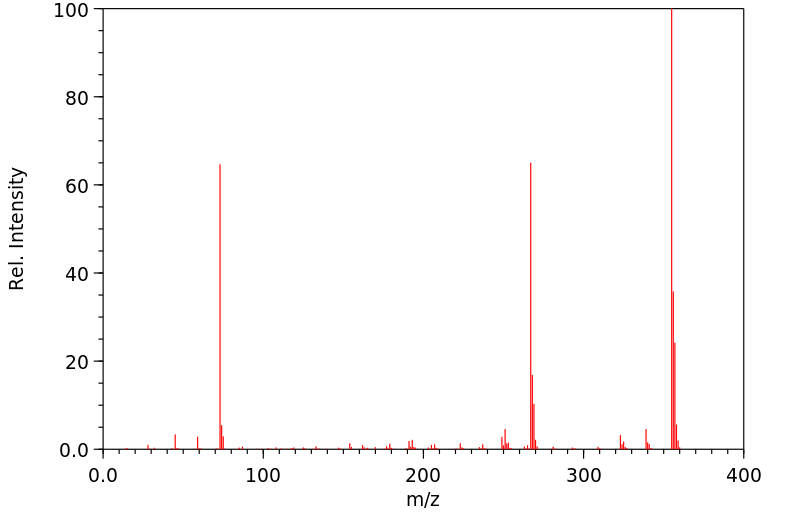模块 1. 化学品 1.1 产品标识符 : 十甲基环五
硅氧烷 产品名称
1.2 鉴别的其他方法 无数据资料
1.3 有关的确定了的物质或混合物的用途和建议不适合的用途 仅用于研发。不作为药品、家庭或其它用途。
模块 2. 危险性概述 2.1 GHS-分类 易燃液体 (类别 4)
皮肤刺激 (类别 3)
眼睛刺激 (类别 2B)
慢性
水生毒性 (类别 4)
2.2 GHS 标记要素,包括预防性的陈述 象形图 无
警示词 警告
危险申明
H227 可燃液体
H316 引起轻微皮肤刺激。
H320 造成眼刺激。
H413 可能对
水生
生物产生长期持续的有害影响。
警告申明
预防措施
P210 远离热源、火花、明火和热表面。- 禁止吸烟。
P264 操作后彻底清洁皮肤。
P273 避免释放到环境中。
P280 穿戴防护手套/ 眼保护罩/ 面部保护罩。
事故响应
P305 + P351 + P338 如与眼睛接触,用
水缓慢温和地冲洗几分钟。如戴隐形眼镜并可方便地取
出,取出隐形眼镜,然后继续冲洗.
P337 + P313 如仍觉眼睛刺激:求医/就诊。
P370 + P378 在发生火灾时:用干砂,干粉或抗溶性泡沫扑灭。
安全储存
P403 + P235 保持低温,存放于通风良好处。
废弃处置
P501 将内容物/ 容器处理到得到批准的废物处理厂。
2.3 其它危害物 - 无
模块 3. 成分/组成信息 3.1 物 质 :
C10H30O5Si5 分子式
: 370.77 g/mol
分子量
组分 浓度或浓度范围
D
ECamethylcyclopentasiloxane
<=100%
化学文摘登记号(CAS
541-02-6 No.) 208-764-9
EC-编号
模块 4. 急救措施 4.1 必要的急救措施描述 一般的建议
请教医生。 向到现场的医生出示此安全技术说明书。
吸入
如果吸入,请将患者移到新鲜空气处。 如呼吸停止,进行人工呼吸。 请教医生。
皮肤接触
用肥皂和大量的
水冲洗。 请教医生。
眼睛接触
用大量
水彻底冲洗至少15分钟并请教医生。
食入
禁止催吐。 切勿给失去知觉者通过口喂任何东西。 用
水漱口。 请教医生。
4.2 主要症状和影响,急性和迟发效应 据我们所知,此
化学,物理和毒性性质尚未经完整的研究。
4.3 及时的医疗处理和所需的特殊处理的说明和指示 无数据资料
模块 5. 消防措施 5.1 灭火介质 灭火方法及灭火剂
用
水雾,抗
乙醇泡沫,干粉或
二氧化碳灭火。
5.2 源于此物质或混合物的特别的危害 碳氧化物,
二氧化硅 5.3 给消防员的建议 如必要的话,戴自给式呼吸器去救火。
5.4 进一步信息 用
水喷雾冷却未打开的容器。
模块 6. 泄露应急处理 6.1 作业人员防护措施、防护装备和应急处置程序 使用个人防护用品。 避免吸入蒸气、烟雾或气体。 保证充分的通风。 移去所有火源。
谨防蒸气积累达到可爆炸的浓度。蒸气能在低洼处积聚。
6.2 环境保护措施 如能确保安全,可采取措施防止进一步的泄漏或溢出。 不要让产品进入下
水道。
一定要避免排放到周围环境中。
6.3 泄漏化学品的收容、清除方法及所使用的处置材料 围堵溢出,用防电真空清洁器或湿刷子将溢出物收集起来,并放置到容器中去,根据当地规定处理(见第13部
分)。 放入合适的封闭的容器中待处理。
6.4 参考其他部分 丢弃处理请参阅第13节。
模块 7. 操作处置与储存 7.1 安全操作的注意事项 避免接触皮肤和眼睛。 避免吸入蒸气和烟雾。
切勿靠近火源。-严禁烟火。采取措施防止静电积聚。
7.2 安全储存的条件,包括任何不兼容性 贮存在阴凉处。 使容器保持密闭,储存在干燥通风处。
打开了的容器必须仔细重新封口并保持竖放位置以防止泄漏。
7.3 特定用途 无数据资料
模块 8. 接触控制和个体防护 8.1 容许浓度 最高容许浓度
没有已知的国家规定的暴露极限。
8.2 暴露控制 适当的技术控制
根据良好的工业卫生和安全规范进行操作。 休息前和工作结束时洗手。
个体防护设备
眼/面保护
带有防护边罩的安全眼镜符合 EN166要求请使用经官方标准如NIOSH (美国) 或 EN 166(欧盟)
检测与批准的设备防护眼部。
皮肤保护
戴手套取 手套在使用前必须受检查。
请使用合适的方法脱除手套(不要接触手套外部表面),避免任何皮肤部位接触此产品.
使用后请将被污染过的手套根据相关法律法规和有效的实验室规章程序谨慎处理. 请清洗并吹干双手
所选择的保护手套必须符合EU的89/686/E
EC规定和从它衍生出来的EN 376标准。
身体保护
防渗透的衣服, 防护设备的类型必须根据特定工作场所中的危险物的浓度和数量来选择。
呼吸系统防护
如危险性评测显示需要使用空气净化的防毒面具,请使用全面罩式多功能防毒面具(US)或ABEK型
(EN
14387)防毒面具筒作为工程控制的候补。如果防毒面具是保护的唯一方式,则使用全面罩式送风防
毒面具。 呼吸器使用经过测试并通过政府标准如NIOSH(US)或CEN(EU)的呼吸器和零件。
模块 9. 理化特性 9.1 基本的理化特性的信息 a) 外观与性状
形状: 透明, 液体
颜色: 无色
b) 气味
无数据资料
c) 气味阈值
无数据资料
d) pH值
无数据资料
e) 熔点/凝固点
-38 °C 在 1,013 hPa
f) 沸点、初沸点和沸程
90 °C 在 13 hPa - lit.210 °C 在 1,013 hPa - lit.
g) 闪点
73 °C - 闭杯
h) 蒸发速率
无数据资料
i) 易燃性(固体,气体)
无数据资料
j) 高的/低的燃烧性或爆炸性限度 无数据资料
k) 蒸气压
0.3 hPa 在 25 °C
41 hPa 在 110.6 °C
l) 蒸汽密度
无数据资料
m) 密度/相对密度
0.958 g/cm3 在 25 °C
n)
水溶性
< 0.00001 g/l 在 23 °C
o) n-
辛醇/
水分配系数
辛醇--
水的分配系数的对数值: 8.023 在 25.3 °C
p) 自燃温度
645.15 K
q) 分解温度
无数据资料
r) 粘度
无数据资料
模块 10. 稳定性和反应活性 10.1 反应性 无数据资料
10.2 稳定性 无数据资料
10.3 危险反应 无数据资料
10.4 应避免的条件 热,火焰和火花。
10.5 不相容的物质 强氧化剂
10.6 危险的分解产物 其它分解产物 - 无数据资料
模块 11. 毒理学资料 11.1 毒理学影响的信息 急性毒性
半数致死剂量 (LD50) 经口 - 大鼠 - > 61,310 mg/kg
半数致死浓度(LC50) 吸入 - 大鼠 - 雄性和雌性 - 4 h - 8.67 mg/l
半数致死剂量 (LD50) 经皮 - 兔子 - > 15,328 mg/kg
皮肤刺激或腐蚀
皮肤 - 兔子 - 轻度的皮肤刺激 - 24 h
眼睛刺激或腐蚀
眼睛 - 兔子 - 轻度的眼睛刺激 - 24 h
呼吸道或皮肤过敏
无数据资料
生殖细胞致突变性
无数据资料
致癌性
IARC:
此产品中没有大于或等于 0。1%含量的组分被 IARC鉴别为可能的或肯定的人类致癌物。
生殖毒性
无数据资料
特异性靶器官系统毒性(一次接触)
无数据资料
特异性靶器官系统毒性(反复接触)
无数据资料
吸入危险
无数据资料
潜在的健康影响
吸入 吸入可能有害。 可能引起呼吸道刺激。
摄入 如服入是有害的。
皮肤 通过皮肤吸收可能有害。 可能引起皮肤刺激。
眼睛 引起眼睛刺激。
接触后的征兆和症状
据我们所知,此
化学,物理和毒性性质尚未经完整的研究。
附加说明
化学物质毒性作用登记: GY5945200
模块 12. 生态学资料 12.1 生态毒性 有溶解度限定时没有毒性
12.2 持久性和降解性 生物降解能力 厌氧的 - 接触时间 28 d
结果: 0.14 % - 不可
生物降解的。
12.3 潜在的生物累积性 生物富集或
生物积累性 肥头鲦鱼 (黑头软口鲦鱼) - 35 d 在 22 °C -0.0011 mg/l
生物富集因子 (BCF): 7,060
方法: 经济合作与发展组织的试验指导书305号
备注: 能在
水生物体内积累。
12.4 土壤中的迁移性 无数据资料
12.5 PBT 和 vPvB的结果评价 无数据资料
12.6 其它不良影响
模块 13. 废弃处置 13.1 废物处理方法 产品
此易爆炸产品可以在备有燃烧后处理和洗刷作用的
化学焚化炉中燃烧
将剩余的和不可回收的溶液交给有许可证的公司处理。
受污染的容器和包装
按未用产品处置。
模块 14. 运输信息 14.1 联合国危险货物编号 欧洲陆运危规: - 国际海运危规: - 国际空运危规: -
14.2 联合国运输名称 欧洲陆运危规: 非危险货物
国际海运危规: 非危险货物
国际空运危规: 非危险货物
14.3 运输危险类别 欧洲陆运危规: - 国际海运危规: - 国际空运危规: -
14.4 包裹组 欧洲陆运危规: - 国际海运危规: - 国际空运危规: -
14.5 环境危险 欧洲陆运危规: 否 国际海运危规 国际空运危规: 否
海洋污染物(是/否): 否
14.6 对使用者的特别提醒 无数据资料
上述信息视为正确,但不包含所有的信息,仅作为指引使用。本文件中的信息是基于我们目前所知,就正
确的安全提示来说适用于本品。该信息不代表对此产品性质的保证。
参见发票或包装条的反面。
模块 15 - 法规信息 N/A
模块16 - 其他信息 N/A








